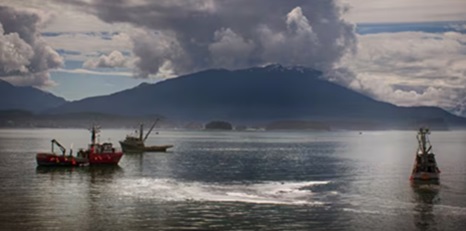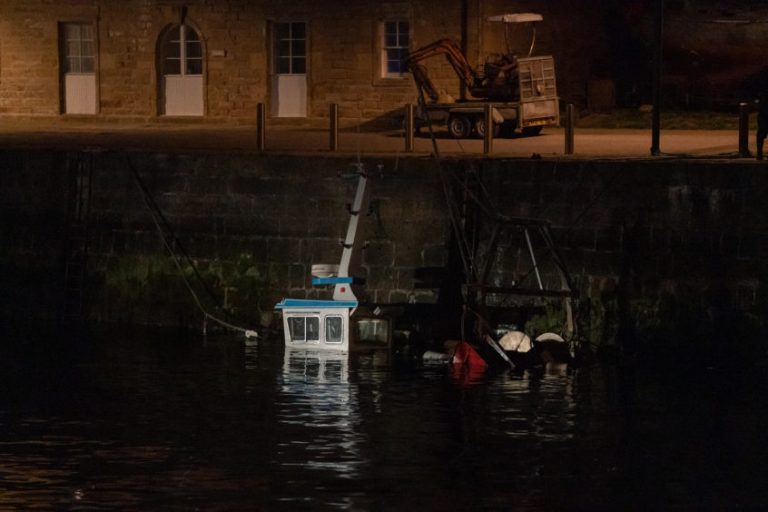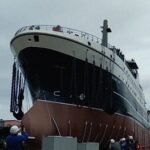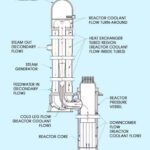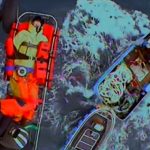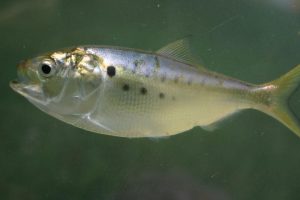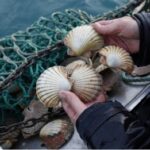Tag Archives: United States
Louisiana shrimpers commend new tariffs, express optimism
 Local shrimpers are hopeful the new tariffs on imported shrimp will bolster the domestic shrimp industry. “We’ve had to get more active and have to go to Baton Rouge or have to go to Washington, D.C. That kind of thing or something that really never happened from our level before,” said Cheri Blanchard with the Southern Shrimp Alliance. Blanchard has witnessed a shift in the local shrimping business over the years. She explains that more than 90% of shrimp consumed in the United States is imported from countries like India, Indonesia and Ecuador, driving down prices and crushing U.S. shrimp owners’ businesses. Video, more, >>CLICK TO READ<< 06:36
Local shrimpers are hopeful the new tariffs on imported shrimp will bolster the domestic shrimp industry. “We’ve had to get more active and have to go to Baton Rouge or have to go to Washington, D.C. That kind of thing or something that really never happened from our level before,” said Cheri Blanchard with the Southern Shrimp Alliance. Blanchard has witnessed a shift in the local shrimping business over the years. She explains that more than 90% of shrimp consumed in the United States is imported from countries like India, Indonesia and Ecuador, driving down prices and crushing U.S. shrimp owners’ businesses. Video, more, >>CLICK TO READ<< 06:36
Sea lamprey control program receives OK to rehire federal workers, after initial scare
 The Great Lakes’ Sea lamprey control program has the OK to rehire three dozen federal employees it needs to combat the eel-like, invasive fish species. That’s after staffing cuts and hiring freezes from the Trump administration last month threatened the work, which the Great Lakes Fishery Commission said would have led to more than $200 million in lost fishing potential. The Great Lakes Fishery Commission is a Canadian American commission which coordinates lamprey control across the Great Lakes region. Each year, the commission contracts workers with the U.S. Fish and Wildlife Service to set traps and apply lampricide in rivers, stopping lamprey before they enter the Great Lakes. more, >>CLICK TO READ<< 10:40
The Great Lakes’ Sea lamprey control program has the OK to rehire three dozen federal employees it needs to combat the eel-like, invasive fish species. That’s after staffing cuts and hiring freezes from the Trump administration last month threatened the work, which the Great Lakes Fishery Commission said would have led to more than $200 million in lost fishing potential. The Great Lakes Fishery Commission is a Canadian American commission which coordinates lamprey control across the Great Lakes region. Each year, the commission contracts workers with the U.S. Fish and Wildlife Service to set traps and apply lampricide in rivers, stopping lamprey before they enter the Great Lakes. more, >>CLICK TO READ<< 10:40

St. Bernard couple’s shrimp boat takes them on a 5-month, 6,000-mile journey around Great Loop
If this were a romantic comedy, it would be called “Tracy and Stacie’s Big Adventure.” If it were a seafaring adventure novel, the title could be “Around the Loop in 125 Days.” Whatever you call it, the five-month nautical journey that St. Bernard residents Tracy and Stacie Alfonso recently completed was the trip of a lifetime. Now the couple is home and their shrimp boat docked once again at Delacroix Island after completing the 6,000-mile Great Loop. Tracy Alfonso, who grew up in a commercial fishing family and shrimped all of his life, had dreamed of navigating the Great Loop since he heard about it. Called the greatest boat adventure in North America, the journey entails circumnavigating much of the United States and parts of Canada. Photos, more, >>CLICK TO READ<< 13:03
Snow crab now crab as FFAW and ASP show willingness to work together
 A week of long days and almost around the clock negotiations has left the Fish, Food and Allied Workers union and the Association of Seafood Producers optimistic that a snow crab harvest will happen this year. “The FFAW and ASP have done an incredible job together to have constructive conversations at this point,” ASP executive director Jeff Loder said Wednesday. “Of course, until you get a deal, you have no deal. But I am cautiously optimistic that we are close.” The two sides are keen to negotiate a deal as soon as possible. A meeting with a price setting panel is scheduled for March 20 should the two sides not make an agreement by then. Video, more, >>CLICK TO READ<< 06:08
A week of long days and almost around the clock negotiations has left the Fish, Food and Allied Workers union and the Association of Seafood Producers optimistic that a snow crab harvest will happen this year. “The FFAW and ASP have done an incredible job together to have constructive conversations at this point,” ASP executive director Jeff Loder said Wednesday. “Of course, until you get a deal, you have no deal. But I am cautiously optimistic that we are close.” The two sides are keen to negotiate a deal as soon as possible. A meeting with a price setting panel is scheduled for March 20 should the two sides not make an agreement by then. Video, more, >>CLICK TO READ<< 06:08
N.S. premier promoting seafood, minerals on New York, Boston trade junket
 Nova Scotia’s premier is promoting the province’s seafood and critical mineral deposits on a tour that will take him to Boston and New York this week and next. “Now, more than ever, we have to diversify our economy,” Houston said in a government release. “We have to go where the buyers are. Nova Scotia has a lot to offer, from high-quality products like seafood and resources like critical minerals.” The province exported more than a billion dollars’ worth of lobster in 2024, making lobster its second largest export. The two countries that collectively import about 80 per cent of live Nova Scotia lobsters are China and the United States, both of which have said lobster will face tariffs in the coming weeks. more, >>CLICK TO READ<< 15:28
Nova Scotia’s premier is promoting the province’s seafood and critical mineral deposits on a tour that will take him to Boston and New York this week and next. “Now, more than ever, we have to diversify our economy,” Houston said in a government release. “We have to go where the buyers are. Nova Scotia has a lot to offer, from high-quality products like seafood and resources like critical minerals.” The province exported more than a billion dollars’ worth of lobster in 2024, making lobster its second largest export. The two countries that collectively import about 80 per cent of live Nova Scotia lobsters are China and the United States, both of which have said lobster will face tariffs in the coming weeks. more, >>CLICK TO READ<< 15:28
Canada commits over C$6 billion to fight impact of US tariffs, find new markets
 Canada on Friday unveiled billions of dollars in aid and other forms of support to businesses and people expected to be directly affected by U.S. tariffs. These relief measures involve over C$6.5 billion ($4.52 billion) of financial aid to help companies tap new international markets, absorb the impact of losses, access easy loans and prevent layoffs, a team of ministers said. U.S. President Donald Trump’s administration imposed 25% tariffs on most imports from Canada and Mexico earlier this week, before announcing a suspension of the charges until April 2 on goods covered by the U.S.-Mexico-Canada Agreement on trade. “We are moving ahead with these changes despite yesterday’s pause because businesses and workers need assurances right now,” Labour Minister Steven MacKinnon said at a news conference on Friday. more, >>CLICK TO READ<< 09:35
Canada on Friday unveiled billions of dollars in aid and other forms of support to businesses and people expected to be directly affected by U.S. tariffs. These relief measures involve over C$6.5 billion ($4.52 billion) of financial aid to help companies tap new international markets, absorb the impact of losses, access easy loans and prevent layoffs, a team of ministers said. U.S. President Donald Trump’s administration imposed 25% tariffs on most imports from Canada and Mexico earlier this week, before announcing a suspension of the charges until April 2 on goods covered by the U.S.-Mexico-Canada Agreement on trade. “We are moving ahead with these changes despite yesterday’s pause because businesses and workers need assurances right now,” Labour Minister Steven MacKinnon said at a news conference on Friday. more, >>CLICK TO READ<< 09:35
‘Cruel’ tariff threats bring endless uncertainty to N.B. fisheries
 Leaders in New Brunswick’s fishing industry are not mincing words when it comes to the cloud of uncertainty hanging over the constant back and forth of tariff threats from U.S. President Donald Trump. “Oh, it’s painful. It’s painful,” said Geoff Irvine, executive director of the Lobster Council of Canada, in an interview. The latest date for tariffs to take effect, now set for April 2, coincides with the opening of lobster season in some sectors of the Atlantic region, but that’s about all Irvine could say for certain about the potential impact. “Honestly, I don’t have a clue. Every single processor, shipper and exporter will have to talk to their customers.” He said the constantly changing news is destabilizing. more, >>CLICK TO READ<< 11:31
Leaders in New Brunswick’s fishing industry are not mincing words when it comes to the cloud of uncertainty hanging over the constant back and forth of tariff threats from U.S. President Donald Trump. “Oh, it’s painful. It’s painful,” said Geoff Irvine, executive director of the Lobster Council of Canada, in an interview. The latest date for tariffs to take effect, now set for April 2, coincides with the opening of lobster season in some sectors of the Atlantic region, but that’s about all Irvine could say for certain about the potential impact. “Honestly, I don’t have a clue. Every single processor, shipper and exporter will have to talk to their customers.” He said the constantly changing news is destabilizing. more, >>CLICK TO READ<< 11:31
Fishing industry watches tariff battle, counting the days till spring seasons
 Like everyone, Nova Scotia’s fishing industry has been trying to parse what U.S. President Donald Trump’s tariffs will mean for them. “It’s too early to know yet,” said Geoff Irvine, executive director of the Lobster Council of Canada. There is little lobster coming ashore right now, which buys the industry time to hope for a resolution that sees the 25 per cent tariff on all Canadian products heading south dropped. Fishing will pick up later this month off southwest Nova Scotia as waters warm, and then in April seasons will start opening from Newfoundland and Prince Edward Island to Nova Scotia, with massive quantities of crustaceans coming over wharves throughout the region by May 1. more, >>CLICK TO READ<< 06:29
Like everyone, Nova Scotia’s fishing industry has been trying to parse what U.S. President Donald Trump’s tariffs will mean for them. “It’s too early to know yet,” said Geoff Irvine, executive director of the Lobster Council of Canada. There is little lobster coming ashore right now, which buys the industry time to hope for a resolution that sees the 25 per cent tariff on all Canadian products heading south dropped. Fishing will pick up later this month off southwest Nova Scotia as waters warm, and then in April seasons will start opening from Newfoundland and Prince Edward Island to Nova Scotia, with massive quantities of crustaceans coming over wharves throughout the region by May 1. more, >>CLICK TO READ<< 06:29
Will the tariff tiff tear at the fabric of Canada-U.S. seafood trade?
 From snow crab and lobster to Pacific salmon, seafood is a trade driver between Canada and the United States. This cross-border commerce has mutually benefited the two nations, but rising trade tensions now threaten this critical supply chain. This month, President Donald Trump has signed executive orders imposing broad tariffs on Canada, Mexico and China, its top trading partners. With a trade war still looming, the seafood sector faces uncertainty over pricing, market access and job security. Across Canada, industry leaders are bracing for economic fallout as possible tariffs could disrupt the flow of seafood between the two nations. The seafood trade between Canada and the United States generates billions in revenue annually, benefiting both countries. Canada imported (U.S.) $3.1 billion worth of seafood in 2023 alone, with the United States supplying the largest share at $1 billion – making up 31 percent of Canada’s total seafood imports. On the flip side, the United States imported more than $3.6 billion in seafood products from Canada, making it the country’s largest supplier. more, >>CLICK TO READ<<< 10:39
From snow crab and lobster to Pacific salmon, seafood is a trade driver between Canada and the United States. This cross-border commerce has mutually benefited the two nations, but rising trade tensions now threaten this critical supply chain. This month, President Donald Trump has signed executive orders imposing broad tariffs on Canada, Mexico and China, its top trading partners. With a trade war still looming, the seafood sector faces uncertainty over pricing, market access and job security. Across Canada, industry leaders are bracing for economic fallout as possible tariffs could disrupt the flow of seafood between the two nations. The seafood trade between Canada and the United States generates billions in revenue annually, benefiting both countries. Canada imported (U.S.) $3.1 billion worth of seafood in 2023 alone, with the United States supplying the largest share at $1 billion – making up 31 percent of Canada’s total seafood imports. On the flip side, the United States imported more than $3.6 billion in seafood products from Canada, making it the country’s largest supplier. more, >>CLICK TO READ<<< 10:39
How Mexican cartels and Chinese criminal networks are moving ‘cocaine of the sea’ through Canadian ports
 Chinese organized crime networks and Mexican cartels are using Canadian ports to trade highly lucrative fish bladders for the precursor chemicals needed to produce fentanyl, according to a memo from the Canada Border Services Agency (CBSA). It said organized criminal networks transport the fish — called totoaba — from the West Coast to China, while the chemical precursors to make toxic drugs are sent through Canadian ports. The report from the CBSA, first obtained by Radio-Canada through a freedom of information request, said Canada is being used as a “transit point” for the illegal product — though the quantity of fish passing through Canada and the amount of fentanyl precursors being exchanged for it, were not included in the report. more, >>CLICK TO READ<< 08:16
Chinese organized crime networks and Mexican cartels are using Canadian ports to trade highly lucrative fish bladders for the precursor chemicals needed to produce fentanyl, according to a memo from the Canada Border Services Agency (CBSA). It said organized criminal networks transport the fish — called totoaba — from the West Coast to China, while the chemical precursors to make toxic drugs are sent through Canadian ports. The report from the CBSA, first obtained by Radio-Canada through a freedom of information request, said Canada is being used as a “transit point” for the illegal product — though the quantity of fish passing through Canada and the amount of fentanyl precursors being exchanged for it, were not included in the report. more, >>CLICK TO READ<< 08:16
Amid ongoing trade tensions, there’s still no timeline on N.L.’s Boston trade office
 A new trade office recently announced by Newfoundland and Labrador Premier Andrew Furey to strengthen commercial relations with New England still isn’t off the ground, as a trade war looms with the United States. Furey announced in September that the provincial government would open a trade office in Boston, located inside the city’s Canadian consulate. Last week, Fisheries Minister Gerry Byrne said the Boston office will play a key role in the province’s navigation of the current economic climate. “One of the key roles of the Boston office [is to] constantly, constantly engage U.S. consumers, U.S. business groups, U.S. congressmen, [U.S.] influencers … to get them to tell the White House that Trump’s decisions are hurting Americans,” Byrne said, appearing on a segment of VOCM’s Open Line. more, >>CLICK TO READ<< 08:29
A new trade office recently announced by Newfoundland and Labrador Premier Andrew Furey to strengthen commercial relations with New England still isn’t off the ground, as a trade war looms with the United States. Furey announced in September that the provincial government would open a trade office in Boston, located inside the city’s Canadian consulate. Last week, Fisheries Minister Gerry Byrne said the Boston office will play a key role in the province’s navigation of the current economic climate. “One of the key roles of the Boston office [is to] constantly, constantly engage U.S. consumers, U.S. business groups, U.S. congressmen, [U.S.] influencers … to get them to tell the White House that Trump’s decisions are hurting Americans,” Byrne said, appearing on a segment of VOCM’s Open Line. more, >>CLICK TO READ<< 08:29
N.B.’s favourite seafood threatened by Trump: lobster industry
 Fishermen would be forced to swallow a depressed price for their catch and processors would have a lot less work, shaking up a commercial enterprise that employs about 5,000 New Brunswickers on boats and another 5,000 in seafood plants. Behind the scenes, the lobster lobby is working feverishly to convince officials in the White House administration and other top Republican officials that imposing a 25 per cent tariff on seafood would be a big mistake for American consumers already reeling from the higher cost of living. The lobster market has long been deeply integrated between Canada and the United States and would be badly wounded by a trade war between the two nations. more, >>CLICK TO READ<< 19:53
Fishermen would be forced to swallow a depressed price for their catch and processors would have a lot less work, shaking up a commercial enterprise that employs about 5,000 New Brunswickers on boats and another 5,000 in seafood plants. Behind the scenes, the lobster lobby is working feverishly to convince officials in the White House administration and other top Republican officials that imposing a 25 per cent tariff on seafood would be a big mistake for American consumers already reeling from the higher cost of living. The lobster market has long been deeply integrated between Canada and the United States and would be badly wounded by a trade war between the two nations. more, >>CLICK TO READ<< 19:53
Fish harvester says possible tariffs leave N.L.’s fishery with a lot of uncertainty
 A pause in the tariff dispute with the United States is not bringing any comfort to Lee Melindy. “We’ve got to have fishing, we’ve got to have processors, and we got a company to send it into the States,” he said. “Those are all a circle. And if one of those pieces of the circle falls apart, it is detrimental on the rest of it.” Melindy is a fish harvester based in Lumsden, N.L. He’s a full-time crew member, deck boss and helps his father — the enterprise owner — in the wheelhouse. It’s been almost 30 years since he first entered the fishery, and he’s seen a lot of changes. “Over the years, I mean, we’ve had uphill battles and we’ve been good and whatnot, but when you’re looking at a possible four years, it could be very serious into the operating of an enterprise,” he said. This week, U.S. president Donald Trump said he would put a hold on his proposed 25 per cent tariffs on Canadian goods for 30 days. With that, Prime Minister Justin Trudeau paused Canada’s counter-tariffs. Video, more, >>CLICK TO READ<<07:30
A pause in the tariff dispute with the United States is not bringing any comfort to Lee Melindy. “We’ve got to have fishing, we’ve got to have processors, and we got a company to send it into the States,” he said. “Those are all a circle. And if one of those pieces of the circle falls apart, it is detrimental on the rest of it.” Melindy is a fish harvester based in Lumsden, N.L. He’s a full-time crew member, deck boss and helps his father — the enterprise owner — in the wheelhouse. It’s been almost 30 years since he first entered the fishery, and he’s seen a lot of changes. “Over the years, I mean, we’ve had uphill battles and we’ve been good and whatnot, but when you’re looking at a possible four years, it could be very serious into the operating of an enterprise,” he said. This week, U.S. president Donald Trump said he would put a hold on his proposed 25 per cent tariffs on Canadian goods for 30 days. With that, Prime Minister Justin Trudeau paused Canada’s counter-tariffs. Video, more, >>CLICK TO READ<<07:30
N.B. lobster processors living with uncertainty as clock ticks on U.S. tariffs reprieve
 Lobster processors in New Brunswick are relieved that U.S. tariffs on Canadian imports have been postponed, but there is still a possibility they will be implemented in March, creating anxiety in the industry. “That’s the frustrating bit,” Nat Richard, executive director of the Lobster Processors Association in the region, said. “It just extends the uncertainty, which is not great for business for sure.” The United States is by far the largest consumer of Canadian lobster. The concern for the lobster industry extends into the United States, as well. Chellie Pingree, the Democratic congresswoman for Maine’s 1st district, said lobster often goes back and forth between the two countries for processing. While diversification of markets is something Richard supports, he said it won’t be simple.”We’re not going to walk away from the U.S. market, whether this is a tariff or not,” said Richard. more, >>CLICK TO READ<< 13:21
Lobster processors in New Brunswick are relieved that U.S. tariffs on Canadian imports have been postponed, but there is still a possibility they will be implemented in March, creating anxiety in the industry. “That’s the frustrating bit,” Nat Richard, executive director of the Lobster Processors Association in the region, said. “It just extends the uncertainty, which is not great for business for sure.” The United States is by far the largest consumer of Canadian lobster. The concern for the lobster industry extends into the United States, as well. Chellie Pingree, the Democratic congresswoman for Maine’s 1st district, said lobster often goes back and forth between the two countries for processing. While diversification of markets is something Richard supports, he said it won’t be simple.”We’re not going to walk away from the U.S. market, whether this is a tariff or not,” said Richard. more, >>CLICK TO READ<< 13:21

Trump to pause promised tariffs for 30 days after speaking with Trudeau
Prime Minister Justin Trudeau said Monday U.S. President Donald Trump will hold off on levying tariffs on Canada for at least 30 days after Canada made a series of commitments to improve security along the border. The country can let out a collective sigh of relief — at least for now. To get Trump to shelve his punishing tariffs, Trudeau told him Canada is pressing ahead with a $1.3-billion border security plan that includes reinforcing the 49th parallel with new choppers, technology and personnel and stepping up its co-ordination with American officials to crack down on Trump’s stated priorities: illegal drugs and migrants. Trudeau said, all told, there will be 10,000 front-line personnel working along the border as part of a push to make it safer. 4 Videos, links, more, >>CLICK TO READ<< 17:49
Danielle Smith: How Team Canada can overcome Trump tariffs
 Like most Canadians, I was very disappointed with U.S. President Donald Trump’s decision to place tariffs on all Canadian goods. This decision will harm both Canadian and American consumers, workers and businesses alike, and strain the historic and important friendship between our two nations. Canada has responded with counter-tariffs of our own on specific U.S. imports that Canadians can generally purchase domestically or source from non-U.S. suppliers. Although I understand the need for this proportionate response, make no mistake, a tariff war with the United States will hurt millions of Canadian families, workers and businesses. As premier of Alberta, I am calling on my fellow premiers, the prime minister and all of our national leaders to de-escalate the rhetoric as much as possible and look to diplomacy and advocacy as our primary tool to resolve this conflict. more, >>CLICK TO READ<< 09:46
Like most Canadians, I was very disappointed with U.S. President Donald Trump’s decision to place tariffs on all Canadian goods. This decision will harm both Canadian and American consumers, workers and businesses alike, and strain the historic and important friendship between our two nations. Canada has responded with counter-tariffs of our own on specific U.S. imports that Canadians can generally purchase domestically or source from non-U.S. suppliers. Although I understand the need for this proportionate response, make no mistake, a tariff war with the United States will hurt millions of Canadian families, workers and businesses. As premier of Alberta, I am calling on my fellow premiers, the prime minister and all of our national leaders to de-escalate the rhetoric as much as possible and look to diplomacy and advocacy as our primary tool to resolve this conflict. more, >>CLICK TO READ<< 09:46
Trump announces tariff talks with Canada, Mexico as global stocks slump
 US President Donald Trump said he will discuss the punishing tariffs he has levied on Canada and Mexico with both countries on Monday, as markets sank on fears over the impact on the global economy. The 25 percent duties — footed by American companies importing from Mexico and Canada — sent European and Asian stocks slumping at the open Monday. The Mexican peso and Canadian dollar also sank against the greenback, while oil jumped despite Trump placing the levy on Canada’s energy imports at 10 percent to limit a spike in fuel prices. more, >>CLICK TO READ<< 08:12
US President Donald Trump said he will discuss the punishing tariffs he has levied on Canada and Mexico with both countries on Monday, as markets sank on fears over the impact on the global economy. The 25 percent duties — footed by American companies importing from Mexico and Canada — sent European and Asian stocks slumping at the open Monday. The Mexican peso and Canadian dollar also sank against the greenback, while oil jumped despite Trump placing the levy on Canada’s energy imports at 10 percent to limit a spike in fuel prices. more, >>CLICK TO READ<< 08:12

Trudeau hits back at the U.S. with big tariffs after Trump launches a trade war
Prime Minister Justin Trudeau announced late Saturday the federal government will hit back against the U.S. after President Donald Trump launched a trade war this weekend with punitive tariffs on all Canadian goods. Trudeau said Canada won’t stand for an attack from a country that was supposed to be an ally and friend. Ottawa will immediately levy retaliatory tariffs on a whole host of American goods as payback for Trump’s attempt to wreck the Canadian economy, Trudeau said. To start, Canada will slap 25 per cent tariffs on $30 billion worth of American goods coming into Canada as of Tuesday. The tariffs will then be applied to another $125 billion worth of American imports in three weeks’ time. Trudeau said there is more non-tariff trade action coming to try to force Trump’s hand and get him to call off the hostilities. Videos. more, >>CLICK TO READ<< 07:11

U.S. tariffs on Canadian goods will come into effect Saturday, White House says
U.S. President Donald Trump on Friday offered vague details on his plans to impose tariffs on goods coming from Canada, Mexico and China, after a spokesperson said they would take effect Saturday. White House press secretary Karoline Leavitt said the president would put a 25 per cent tariff on Canada and Mexico and a 10 per cent tariff on goods from China during a briefing on Friday. Speaking to reporters in the Oval Office hours later, Trump said he expects the tariffs would include oil, gas, steel, aluminum, copper and microchips — but potentially with staggered dates and rates, depending on the product. Foreign Affairs Minister Mélanie Joly said she heard the president’s public comments but had not received any further information. more, >>CLICK TO READ<< 09:36
A rundown of Trump’s executive actions
 President Donald Trump wasted no time announcing steps to implement many of his campaign pledges, including on immigration, energy, the military and federal workforce, casting many as reversing the policies of his predecessor, Joe Biden. “We will immediately restore the integrity, competency and loyalty of America’s government,” Trump said in his inaugural address on Monday (Tuesday AEDT). “With these actions, we will begin the complete restoration of America, and the revolution of common sense.” While Trump is still signing more orders on Monday night in Washington, here’s a brief rundown of what we know so far that his administration plans to initiate, taken from his speech, public information about the orders, briefings by incoming officials and public statements. more, >>CLICK TO READ<< 06:23
President Donald Trump wasted no time announcing steps to implement many of his campaign pledges, including on immigration, energy, the military and federal workforce, casting many as reversing the policies of his predecessor, Joe Biden. “We will immediately restore the integrity, competency and loyalty of America’s government,” Trump said in his inaugural address on Monday (Tuesday AEDT). “With these actions, we will begin the complete restoration of America, and the revolution of common sense.” While Trump is still signing more orders on Monday night in Washington, here’s a brief rundown of what we know so far that his administration plans to initiate, taken from his speech, public information about the orders, briefings by incoming officials and public statements. more, >>CLICK TO READ<< 06:23
“THE FISH THIEF: A Great Lakes Mystery”
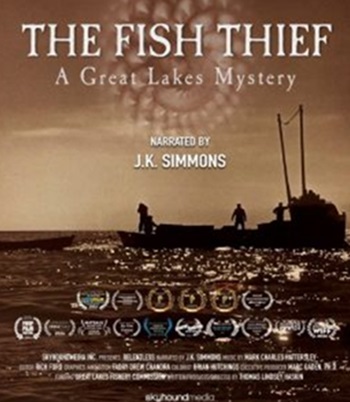 “THE FISH THIEF,” narrated by Oscar-winning actor J.K. Simmons, delves into the extraordinary effort to uncover the cause of a devastating environmental crisis. Was it overfishing, pollutants, or something else? Scientists on both sides of the border worked tirelessly to solve the mystery. In a dramatic eleventh-hour breakthrough, they discovered the true culprit: the invasive sea lamprey. This notorious predator arrived in the Great Lakes in the early twentieth century, triggering an ecological crisis and nearly wiping out populations of lake trout, whitefish, and other cornerstone species. The impact reverberated across the region, ruining local industries, damaging small town economies and indigenous communities, and destroying the livelihoods of people on both sides of the U.S. and Canadian border. A dedicated group of international scientists, policymakers, and conservationists banded together in a race against time to address this ecological invasion. more, >>CLICK TO READ<< 10:42
“THE FISH THIEF,” narrated by Oscar-winning actor J.K. Simmons, delves into the extraordinary effort to uncover the cause of a devastating environmental crisis. Was it overfishing, pollutants, or something else? Scientists on both sides of the border worked tirelessly to solve the mystery. In a dramatic eleventh-hour breakthrough, they discovered the true culprit: the invasive sea lamprey. This notorious predator arrived in the Great Lakes in the early twentieth century, triggering an ecological crisis and nearly wiping out populations of lake trout, whitefish, and other cornerstone species. The impact reverberated across the region, ruining local industries, damaging small town economies and indigenous communities, and destroying the livelihoods of people on both sides of the U.S. and Canadian border. A dedicated group of international scientists, policymakers, and conservationists banded together in a race against time to address this ecological invasion. more, >>CLICK TO READ<< 10:42
‘A lot of anxiety’: N.L. seafood industry will see big hit if Trump follows through with tariffs
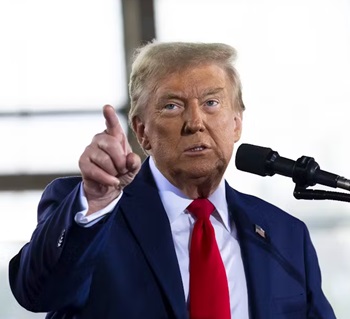 President-elect Donald Trump’s 25 per cent tariff threat is worrying people in Newfoundland and Labrador’s seafood industry. More than 60 per cent of the province’s seafood is sold in the United States. “There’s certainly a lot of anxiety right now in the seafood industry, and I’m no exception,” said Labrador Gem Seafoods’ president Danny Dumaresque in an interview with The Telegram on Wednesday, Nov. 27. Trump said in a social media post Monday night that on his first day in office, he would impose the tariffs until Canada and Mexico stop illegal border crossings and prevent drugs such as fentanyl from entering the U.S. “Both Mexico and Canada have the absolute right and power to easily solve this long simmering problem. We hereby demand that they use this power, and until such time that they do, it is time for them to pay a very big price!” Trump wrote on his social media platform Truth Social. more, >>CLICK TO READ<< 07:57
President-elect Donald Trump’s 25 per cent tariff threat is worrying people in Newfoundland and Labrador’s seafood industry. More than 60 per cent of the province’s seafood is sold in the United States. “There’s certainly a lot of anxiety right now in the seafood industry, and I’m no exception,” said Labrador Gem Seafoods’ president Danny Dumaresque in an interview with The Telegram on Wednesday, Nov. 27. Trump said in a social media post Monday night that on his first day in office, he would impose the tariffs until Canada and Mexico stop illegal border crossings and prevent drugs such as fentanyl from entering the U.S. “Both Mexico and Canada have the absolute right and power to easily solve this long simmering problem. We hereby demand that they use this power, and until such time that they do, it is time for them to pay a very big price!” Trump wrote on his social media platform Truth Social. more, >>CLICK TO READ<< 07:57
California’s Squid Fishery: The Largest in the U.S. and an Economic Powerhouse
 California holds a unique distinction in the United States as home to the largest squid fishery by both volume and revenue. While most Americans might think of squid as a side dish or appetizer at seafood restaurants, in California, market squid fishing has a deep-rooted history and serves as a significant contributor to the state’s commercial fishing economy. California’s market squid (Doryteuthis opalescens), commonly known as opalescent squid, not only drives revenue and jobs in the fishing industry but also exemplifies how sustainable practices are becoming integral to modern fisheries. From humble beginnings to MSC-certified status, California’s squid fishery is a fascinating example of how one invertebrate species has created waves in the fishing world. more, >>CLICK TO READ<< 15:21
California holds a unique distinction in the United States as home to the largest squid fishery by both volume and revenue. While most Americans might think of squid as a side dish or appetizer at seafood restaurants, in California, market squid fishing has a deep-rooted history and serves as a significant contributor to the state’s commercial fishing economy. California’s market squid (Doryteuthis opalescens), commonly known as opalescent squid, not only drives revenue and jobs in the fishing industry but also exemplifies how sustainable practices are becoming integral to modern fisheries. From humble beginnings to MSC-certified status, California’s squid fishery is a fascinating example of how one invertebrate species has created waves in the fishing world. more, >>CLICK TO READ<< 15:21
Lack of fishing prohibitions in ‘grey zone’ could pose risk for right whales, expert says
 One marine conservation expert has questions about the efforts on the part of Fisheries and Oceans after North Atlantic right whales were detected in the Bay of Fundy in recent weeks, including in an area where both Canadian and American fishermen catch lobster. In October, Fisheries and Oceans announced several temporary prohibited fishing areas as the whales were detected in multiple fishing spots across the Maritimes, including in the bay. Some fishing prohibitions for parts of the Bay of Fundy started on Oct. 25 and included the fisheries for crab, herring, mackerel, groundfish, hagfish and lobster. The so-called “grey zone” is an area of disputed water near Grand Manan. Both Canada and the United States have claimed sovereignty over the area, so fishers from both countries harvest there. more, >>CLICK TO READ<< 07:57
One marine conservation expert has questions about the efforts on the part of Fisheries and Oceans after North Atlantic right whales were detected in the Bay of Fundy in recent weeks, including in an area where both Canadian and American fishermen catch lobster. In October, Fisheries and Oceans announced several temporary prohibited fishing areas as the whales were detected in multiple fishing spots across the Maritimes, including in the bay. Some fishing prohibitions for parts of the Bay of Fundy started on Oct. 25 and included the fisheries for crab, herring, mackerel, groundfish, hagfish and lobster. The so-called “grey zone” is an area of disputed water near Grand Manan. Both Canada and the United States have claimed sovereignty over the area, so fishers from both countries harvest there. more, >>CLICK TO READ<< 07:57
America’s Least Desired Job: Being a Commercial Fisherman, According to Survey
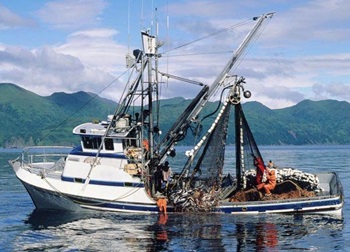 While being a Hollywood actor in California, an investment banker in New York, or an outdoor adventure guide in Colorado may top the list of America’s most coveted careers, we often overlook the jobs that people least aspire to. The survey revealed some interesting results. Among Americans, the job they would least be willing to do, even if offered double the salary, was that of a commercial fisherman. Commercial fishing is one of the most hazardous jobs in America. Here are some of the other least desired careers among Americans: more, >>CLICK TO READ<< 07:57
While being a Hollywood actor in California, an investment banker in New York, or an outdoor adventure guide in Colorado may top the list of America’s most coveted careers, we often overlook the jobs that people least aspire to. The survey revealed some interesting results. Among Americans, the job they would least be willing to do, even if offered double the salary, was that of a commercial fisherman. Commercial fishing is one of the most hazardous jobs in America. Here are some of the other least desired careers among Americans: more, >>CLICK TO READ<< 07:57
Southern Shrimp Alliance Welcomes NOAA Fisheries’ Confirmation that U.S. Wild-Caught Shrimp Is the Sustainable Choice
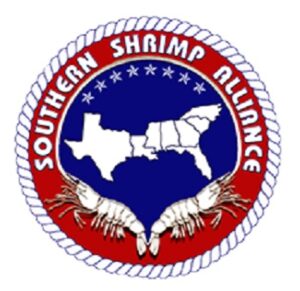 Last week, NOAA Fisheries published an on-line resource with facts regarding wild-caught American shrimp, explaining what makes it a sustainable seafood choice. Shrimp is, far and away, the most popular seafood in America. As NOAA Fisheries explains, “now about one-quarter of the seafood Americans eat is shrimp.” Yet, despite Americans’ love of shrimp, the U.S. shrimp industry is struggling. NOAA Fisheries notes that despite the fact that landings volumes were roughly the same in 2023 as they were in 2022, preliminary data from the Gulf of Mexico show that the industry sold $329 million of wild-caught shrimp in 2022 and that revenue dropped to $204 million in 2023 – a 38 percent drop.” more, >>CLICK TO READ<< 16:29
Last week, NOAA Fisheries published an on-line resource with facts regarding wild-caught American shrimp, explaining what makes it a sustainable seafood choice. Shrimp is, far and away, the most popular seafood in America. As NOAA Fisheries explains, “now about one-quarter of the seafood Americans eat is shrimp.” Yet, despite Americans’ love of shrimp, the U.S. shrimp industry is struggling. NOAA Fisheries notes that despite the fact that landings volumes were roughly the same in 2023 as they were in 2022, preliminary data from the Gulf of Mexico show that the industry sold $329 million of wild-caught shrimp in 2022 and that revenue dropped to $204 million in 2023 – a 38 percent drop.” more, >>CLICK TO READ<< 16:29
Is U.S. Wild-Caught Shrimp Sustainable? The Short Answer Is Yes
 U.S.-harvested shrimp is nutritious, delicious… and sustainable! The shrimp fishery has also historically been a culturally important economic engine. It provides a livelihood for thousands of U.S. commercial fishermen. U.S. shrimp are a sustainable seafood option, and the United States sets a global precedent for shrimp trawl bycatch reduction. But our nation’s shrimp industry is struggling to stay afloat and there’s confusion about its sustainability. Here are the facts about U.S. wild-caught shrimp. Most U.S. shrimp are caught in the Southeast from Texas to North Carolina. Three species—white shrimp, pink shrimp, and brown shrimp—make up the vast majority of the shrimp caught. more, >>CLICK TO READ<< 10:22
U.S.-harvested shrimp is nutritious, delicious… and sustainable! The shrimp fishery has also historically been a culturally important economic engine. It provides a livelihood for thousands of U.S. commercial fishermen. U.S. shrimp are a sustainable seafood option, and the United States sets a global precedent for shrimp trawl bycatch reduction. But our nation’s shrimp industry is struggling to stay afloat and there’s confusion about its sustainability. Here are the facts about U.S. wild-caught shrimp. Most U.S. shrimp are caught in the Southeast from Texas to North Carolina. Three species—white shrimp, pink shrimp, and brown shrimp—make up the vast majority of the shrimp caught. more, >>CLICK TO READ<< 10:22
Fishermen Taking Aim At Offshore Wind Projects Across Texas
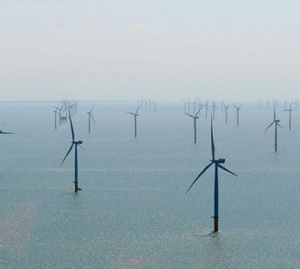 Fishermen are taking aim at offshore wind projects across Texas and the United States. On the same day that the Biden Administration pulled the plug on the second lease auction of a major proposed offshore wind project near the LA-TX border, the Bureau of Ocean Energy Management (BOEM) announced that it had been approached by “Hecate Energy Gulf Wind LLC (Hecate Energy) to acquire commercial wind energy lease(s) on the Outer Continental Shelf (OCS) in the Gulf of Mexico.” This potential project would transform thousands of aquatic acres into a wind farm. more, >>CLICK TO READ<< 17:04
Fishermen are taking aim at offshore wind projects across Texas and the United States. On the same day that the Biden Administration pulled the plug on the second lease auction of a major proposed offshore wind project near the LA-TX border, the Bureau of Ocean Energy Management (BOEM) announced that it had been approached by “Hecate Energy Gulf Wind LLC (Hecate Energy) to acquire commercial wind energy lease(s) on the Outer Continental Shelf (OCS) in the Gulf of Mexico.” This potential project would transform thousands of aquatic acres into a wind farm. more, >>CLICK TO READ<< 17:04
A Historic Agreement – Canada and U.S. suspend all fishing for Canadian-origin Yukon River chinook salmon
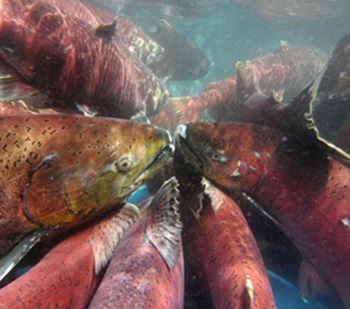 Canada and the United States are suspending all fishing for Canadian-origin Yukon River chinook salmon for seven years in an attempt to protect the dwindling species. The agreement covers the length of one life cycle of the fish and recognizes that the “persistent decline of chinook salmon” has led to an inability to meet conservation objectives in both countries. more, >>CLICK TO READ<< – Canada and Alaska sign a historic agreement to protect Yukon River Chinook salmon, To ensure the protection and recovery of Yukon River Chinook salmon, Fisheries and Oceans Canada and the Alaska Department of Fish and Game have signed a historic seven-year agreement. more, >>Click to read<< 10:33
Canada and the United States are suspending all fishing for Canadian-origin Yukon River chinook salmon for seven years in an attempt to protect the dwindling species. The agreement covers the length of one life cycle of the fish and recognizes that the “persistent decline of chinook salmon” has led to an inability to meet conservation objectives in both countries. more, >>CLICK TO READ<< – Canada and Alaska sign a historic agreement to protect Yukon River Chinook salmon, To ensure the protection and recovery of Yukon River Chinook salmon, Fisheries and Oceans Canada and the Alaska Department of Fish and Game have signed a historic seven-year agreement. more, >>Click to read<< 10:33






